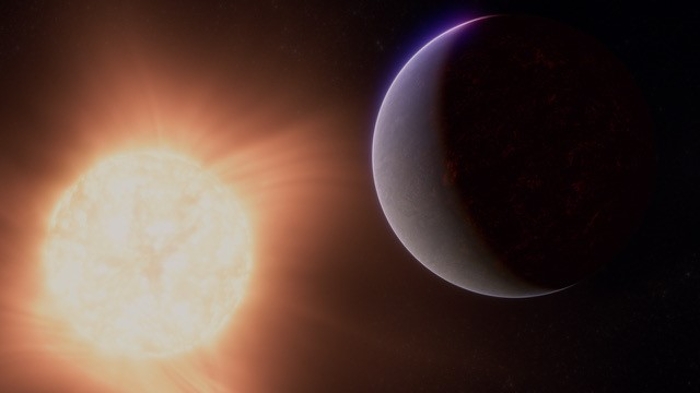Leiden University: Webb Data Suggest Atmosphere around Rocky Exoplanet
Renyu Hu from NASA’s Jet Propulsion Laboratory (JPL) in Pasadena, California, is lead author on a paper published today in Nature. “Webb is pushing the frontiers of exoplanet characterization to rocky planets,” Hu said. “It is truly enabling a new type of science.”
Super-Hot Super-Earth 55 Cancri e
55 Cancri e, also known as Janssen, is one of five known planets orbiting the Sun-like star 55 Cancri, in the constellation Cancer. With a diameter nearly twice that of Earth and density slightly greater, the planet is classified as a super-Earth: larger than Earth, smaller than Neptune, and likely similar in composition to the rocky planets in our solar system.
To describe 55 Cancri e as “rocky,” however, could leave the wrong impression. The planet orbits so close to its star (about 1.4 million miles, or one-twenty-fifth the distance between Mercury and the Sun) that its surface is likely to be molten – a bubbling ocean of magma. With such a tight orbit, the planet is also likely to be tidally locked, with a dayside that faces the star at all times and a nightside in perpetual darkness.
In spite of numerous observations since it was discovered to transit in 2011, the question of whether or not 55 Cancri e has an atmosphere – or even could have one given its high temperature and the continuous onslaught of stellar radiation and wind from its star – has gone unanswered.
“Most of my research has been focused on trying to unravel the ambiguous nature of this planet”, said Mantas Zilinskas, a Postdoctoral researcher at the Netherlands Institute for Space Research (SRON) and co-author on the study. “With Webb, we can finally start putting strong constraints on super-Earths, shedding light on their atmospheres and compositions with unprecedented detail.”
Unlike the atmospheres of gas giant planets, which are relatively easy to spot (the first was detected by NASA’s Hubble Space Telescope more than two decades ago), thinner and denser atmospheres surrounding rocky planets have remained elusive.
Previous studies of 55 Cancri e using data from NASA’s now-retired Spitzer Space Telescope suggested the presence of a substantial atmosphere rich in volatiles (molecules that occur in gas form on Earth) like oxygen, nitrogen, and carbon dioxide. But researchers could not rule out another possibility: that the planet is bare, save for a tenuous shroud of vaporized rock, rich in elements like silicon, iron, aluminum, and calcium. “The planet is so hot that some of the molten rock should evaporate,” explained Hu.
Measuring Subtle Variations in Infrared Colors
To distinguish between the two possibilities, the team used Webb’s NIRCam (Near-Infrared Camera) and MIRI (Mid-Infrared Instrument) to measure 4- to 12-micron infrared light coming from the planet.
Although Webb cannot capture a direct image of 55 Cancri e, it can measure subtle changes in light from the system as the planet orbits the star.
By subtracting the brightness during the secondary eclipse, when the planet is behind the star (starlight only), from the brightness when the planet is right beside the star (light from the star and planet combined), the team was able to calculate the amount of various wavelengths of infrared light coming from the dayside of the planet.

